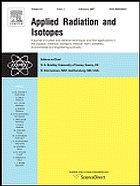|
Literature / Source Database:
Applied Radiation and Isotopes
Description
A journal of nuclear and radiation techniques and their applications in the physical, chemical, biological, medical, earth, planetary, environmental and engineering science.
| Title (short) |
Appl. Radiat. Isot. |
| Languages |
English |
| First year |
1956 |
| Impact factor |
1.136 |
| Editor |
W.L. McLaughlin, D.M. Taylor |
|
|

|
Status
active
Indexing
Analytical Abstracts, Applied Health Physics Abstracts, BIOSIS, Cambridge Scientific Abstracts, Chemical Abstracts, Current Contents/BIOMED Database, Current Contents/Life Sciences, Current Contents/Physics, Chemical, & Earth Sciences, Current Con
Predecessor
Subject

Source type
Journal
Publisher
ISBN ISSN
0969-8043
First volume
44
Last volume
66+
Publish city
Amsterdam
Homepage
| Resources |
|
Availability |
|
|
|
|
|
| Text PDF |
 |
free access |
 |
| Text Html |
 |
for subscriber |
 |
| References |
 |
not available |
 |
| Abstracts |
 |
|
|
| TOC |
 |
|
|
|
|
|
|

Description
Applied Radiation and Isotopes provides a high quality medium for the publication of substantial, original and scientific and technological papers on the development and applications of nuclear, radiation and radionuclide techniques in chemistry, physics, biochemistry, biology, medicine, engineering and in the earth, planetary and environmental sciences. Nuclear techniques are defined in the broadest sense and both experimental and theoretical papers are welcome. They include the development and use of α- and β-particles, X-rays and γ-rays, neutrons and other nuclear particles and radiations from all sources, including radionuclides, accelerators, cyclotrons and reactors and from the natural environment. Nuclear magnetic resonance and electron spin resonance are important technologies within the scope of Applied Radiation and Isotopes.
Relevant topics for Applied Radiation and Isotopes include the following, however, authors are encouraged to suggest other topics which might also be published in the journal:
• Radiation sources: Design, construction, production, characteristics.
• Radionuclides: Production, activation cross-sections, target design, processing, quality control procedures.
• Synthesis of labelled compounds: Synthesis, purification, quality control, in vitro testing of radionuclide-labelled compounds/ radiopharmaceuticals.
• Measurement of radiation and radioactivity: Measurement of X-rays, γ-rays, χ- and β-particles and other forms of radiation; nuclear instrumentation, including radiation spectrometry, dosimetry, novel counting systems and whole-body counters, novel radiation detector systems.
• Radioanalytical methods: Activation analysis, isotope dilution analysis, radioimmunoassay, radionuclide tomography, radiation spectrometry.
• Nuclear physics and chemistry topics including data compilations, directly relevant to practical applications.
• Nuclear geophysics: Studies of the earth's crust, the hydrosphere, the atmosphere and planetary bodies; nuclear methods for exploration, extraction, transport and use of water, oil, gas, coal and other minerals.
• Radiochemistry: Chemical behaviour and speciation of radionuclides.
• Environment: Chemical behaviour and speciation of radionuclides and labelled compounds other than those of direct clinical interest, in geological, environmental, human, animal or plant systems; factors which modify this behaviour.
|